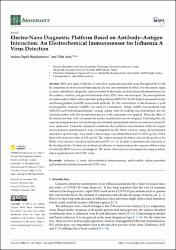Electro-Nano Diagnostic Platform Based on Antibody-Antigen Interaction: An Electrochemical Immunosensor for Influenza A Virus Detection
Citation
Büyüksünetçi YT, Anık Ü. Electro-Nano Diagnostic Platform Based on Antibody-Antigen Interaction: An Electrochemical Immunosensor for Influenza A Virus Detection. Biosensors (Basel). 2023 Jan 23;13(2):176. doi: 10.3390/bios13020176. PMID: 36831942; PMCID: PMC9953406.Abstract
H1N1 is a kind of influenza A virus that causes serious health issues throughout the world. Its symptoms are more serious than seasonal flu and can sometimes be lethal. For this reason, rapid, accurate, and effective diagnostic tests are needed. In this study, an electrochemical immunosensor for the sensitive, selective, and practical detection of the H1N1 virus was developed. The sensor platform included multi-walled carbon nanotube gold-platinum (MWCNT-Au-Pt) hybrid nanomaterial and anti-hemagglutinin (anti-H1) monoclonal antibody. For the construction of this biosensor, a gold screen-printed electrode (AuSPE) was used as a transducer. Firstly, AuSPE was modified with MWCNT-Au-Pt hybrid nanomaterial via drop casting. Anti-H1 antibody was immobilized onto the electrode surface after the modification process with cysteamine was applied. Then, the effect of the interaction time with cysteamine for surface modification was investigated. Following that, the experimental parameters, such as the amount of hybrid nanomaterial and the concentration of anti-H1 were optimized. Under the optimized conditions, the analytical characteristics of the developed electrochemical immunosensor were investigated for the H1N1 virus by using electrochemical impedance spectroscopy. As a result, a linear range was obtained between 2.5-25.0 µg/mL with a limit of the detection value of 3.54 µg/mL. The relative standard deviation value for 20 µg/mL of the H1N1 virus was also calculated and found as 0.45% (n = 3). In order to determine the selectivity of the developed anti-H1-based electrochemical influenza A immunosensor, the response of this system towards the H3N2 virus was investigated. The matrix effect was also investigated by using synthetic saliva supplemented with H1N1 virus.


















